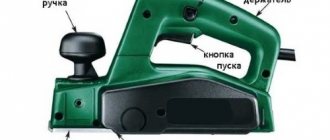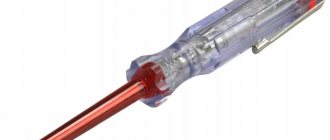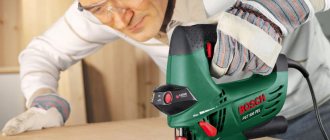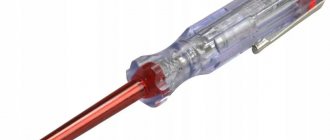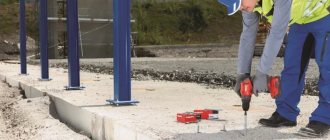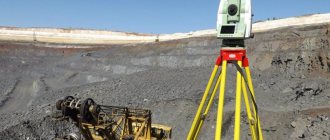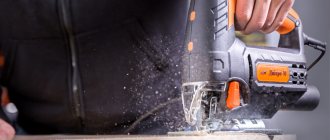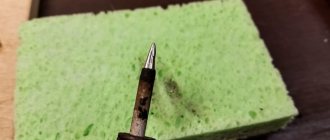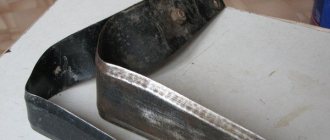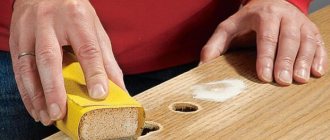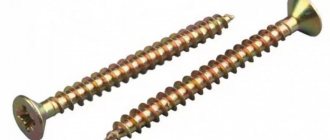How to use a bubble level with three bubbles
The bubble level is easy to work with, and horizontal and vertical capsules are rarely an issue. Measurements are carried out by applying the device to the planes, as when checking and adjusting. The position of the bubble is observed in the same way; it should be in the center if the surfaces are smooth.
But the rules for using an inclined ampoule are not so obvious. This peephole is designed to check the angle of the plane. Next to it there is usually a rotating mechanism that allows you to adjust the ampoule to arbitrarily determine the inclination.
In budget devices, the third capsule is not adjustable and allows you to measure only an angle of 45°
The third bubble is used according to the following algorithm:
Operating technique
To use the building level correctly, you need to study its parameters. The operating principle is the same for each device.
Using Bubble Type
The device is applied to the work surface, and the builder observes the air bubble. It should be located in the middle of the capsule.
Deviation of the bubble from the norm means:
- The air capsule is shifted to the left. It is necessary to lower the left side of the tool or raise the right one.
- Move the bubble to the right side. Lower the right side of the level or raise the left.
The popular bubble level requires state control. If the tool is dropped, it must be calibrated before use. Unlike other devices, a level cannot be a comprehensive device. The choice of its type, length and functions depends on the purpose: for minor work, finishing, installation, repair of external walls, laying bricks.
How to calibrate the device and why it is needed
Few people know that even at the stage of purchasing bubble levels, it is necessary to check the accuracy of their functioning. Perhaps you have been using the level for a long time, and at the same time you did not even realize that the measurements it performs are carried out with errors. If this is the case, then it's time to not only check your tool, but also fix it. To begin with, it is worth noting that bubble level calibration is a procedure by which the measuring part of the instrument is brought to an ideal state.
Not only levels that have a special adjustment system in the form of screws can be calibrated, but also devices that do not have such a mechanism. First, let's look at the procedure for calibrating a level that has a setting system. The calibration instructions are as follows:
Read also: Color combination in clothes
- Fill the bathtub with water, and taking a sheet of foam plastic, immerse it in the water so that it floats and does not touch the walls of the bathtub.
- Place a level on the surface of the foam, and by rotating the screws, adjust the position of the bubble until it is exactly in the center between the marks
- Rotate the level vertically 180 degrees and re-adjust if necessary
Calibration of a bubble type level lasts until the bubble on the device is located exactly in the center of the flask when the level is positioned in different horizontal directions. This is the essence of tuning or calibration.
If the level does not have adjusting screws, then it can also be adjusted. This is done using a reference device. Without a device that is accurately calibrated, it is possible to adjust a faulty device, but it will take a lot of time. The principle of level calibration without adjusting screws is as follows:
- If an auxiliary level is used that does not require calibration, then both instruments should be placed next to each other on a level and stable surface
- When the bubble is located exactly in the center on the reference device, you should use a hammer and a punch. To level the reference level, you can use sheets of paper that are placed under the required side
- Using a punch and a hammer, you should strike the plastic part of the flask for the level that needs adjustment. The blows must be applied on the opposite side of the bubble displacement. Please note that hitting the glass bulb is prohibited.
The procedure is repeated similarly when rotating the levels by 180 degrees. If there is no reference level, then you can determine where to strike using a bathtub filled with water and a sheet of foam. If you need to calibrate the flask responsible for the vertical plane, then this is much easier. To do this, remove the plug to provide access to the flask, and, leaning the faulty device against the reference level, make adjustments.
More details on how to calibrate the level yourself are presented in the video.
Varieties
The selection of the building level should be taken seriously. This will not only save money, but also improve the quality of the work performed. Professional builders distinguish 5 main types of this construction tool:
- Bubble.
- Electronic.
- Pipe.
- Hydraulic.
- Laser.
Bubble
It is the most popular tool because it is easy to use and versatile.
They got their name because the main and sensitive element is an air bubble that floats on the surface of the liquid inside the ampoule. Important!
Bubble-type building levels have an error of 0.6/1 mm per meter.
All levels of domestic production meet GOST 94 16 - 83. It specifies the basic conditions for the technology of their production.
In their design, all models of this type have:
- hollow body;
- stiffening rib;
- ampoule with air;
- protective glass;
- measurement scale in millimeters.
To reduce the weight of the device, the main metal used in production is aluminum. They vary in length - from 25 centimeters to 3 meters or more.
There are also special tools of this type that are used when installing metal structures. They will definitely have magnets included. They attach the entire device to the surface of the metal structure.
For masons, it is best to use a level in their work, the body of which is reinforced and cast.
Electronic
Devices of this type belong to tools for professionals. In its design it necessarily includes:
- goniometer;
- several ampoules with air;
- digital display;
- hollow body;
- protective glass;
- scale with values, which are indicated in millimeters.
The special feature is the digital display. It shows deviation data. This value is calculated in degrees. You can also record measured slopes. If the slope is from 0 to 90 degrees, it will notify with a signal.
It is easy to check the accuracy of this type of building level. To do this you need:
- Place it on a flat surface.
- Take readings.
- Turn 180 degrees.
- Remove new values.
Important! If the difference between the readings differs by more than 0.3 degrees, then the device must be calibrated.
Pipe
This type of building levels is used when laying water supply, sewerage and gas pipelines. It allows pipes to be installed strictly horizontally or vertically when arranging communications. It is also convenient to work with various beams and rounded profiles. The main feature of the pipe profile is its shape in the form of a Latin letter - “V”, as well as magnets that make it easy to install the level on metal surfaces.
This type of level has the same design as the bubble level. The deviation indicates an air bubble in the glass ampoule.
Hydraulic
This device is used when it is necessary to apply horizontal markings on construction sites that are located at a distance from each other. For example, it is used in the construction of foundations, laying brick walls and other construction elements that are located in the same planes.
Its design includes a pair of vessels that are connected to each other by a tube made of transparent plastic or glass. Before you start working, you need to fill it with water to two-thirds of the volume of the flask. The water inside the device must be free of air bubbles. If they are present, then you need to get rid of them. They affect the accuracy of measurements.
To ensure accurate markings, it is best to use one starting point.
Laser
Another name is “levels”. Just like electronic levels, they belong to professional equipment. They cost much more, but have a lot of additional characteristics.
This is the most accurate equipment. The deviation is 0.1/1 mm per meter. Used in the construction of surfaces horizontally, vertically and on inclined planes. The distance between construction objects can reach several 10 meters.
Important! There are rotating laser levels that cover the entire area that is in the area.
Water building level
The water level is famous for its simplicity in making it yourself. In addition, its price is low, but the accuracy of this meter will not be lower than the accuracy of a laser level, which is more expensive. In addition to using such a tool in installing walls and laying floors, it can be used to levelly install interior items such as wall shelves, paintings, lamps, and wall cabinets. Due to the fact that the level itself consists of a transparent flexible hose connecting two tubes, and that it can be used to install several things at once, it is much more convenient to invite a second person to work with the water level.
Using a water level:
Using a water level will not seem simple at first glance, because it involves several preparation steps.
You need to fill the level with water, making sure that no air bubbles or other foreign substances get into it. To check for air bubbles, you can pull the hose vertically, holding it in the middle with your foot, and look through it into the light. Make sure that when both ends approach each other, the water level is the same. To make this easier, color the water any color you like.
Next, you need to make a mark on the wall at a predetermined height and, placing one of the tubes against it, move the hose up or down to equalize the water level with the point made.
Having secured the first end of the level, you need to install the second one in the right place. As soon as the water level in it is equal to the water level in the first tube, it will be possible to make a second mark.
Connect the resulting marks with one line, using a special dyed thread, which will leave a noticeable imprint on the wall. You can make any number of such marks, the main thing is to ensure that the water level at the original mark does not change.
When measuring the perimeter of the entire room and setting marks, it is necessary that the line after the last point coincides with the first.
How to use a bubble level to determine a vertical surface
Using the second flask on the device, the evenness of vertical surfaces is checked, for example, the quality of brickwork, plaster, plasterboard sheets, etc. To do this, you need to lean the device against the surface and look at the location of the bubble. It should be exactly in the center, which indicates the evenness of the surface.
It is important to consider that the vertical surface is measured so that the flask with the bubble is at the top. This simplifies not only reading the result, but also reduces the error.
Laser level
Laser levels and levels are very complex devices. Each of the emitter blocks has two degrees of freedom of regulation. One of them is responsible for the tilt of the horizon (for plane builders and rotary devices), the other for the angle of attack of the laser (the height of the end point of the beam). Like any device, during operation the laser level experiences shaking, light shocks, and temperature changes. Therefore, its accuracy is reduced. This means that even with a minimal beam error, you can get a deviation of, for example, a seam of 6-10 mm in a large room.
How to learn to use the third flask at a level
Difficulties in operating a bubble level arise when the user tries to understand what the third flask on the device is for and how to use it. To learn how to properly use a three-bulb level, you need to understand that it is designed to check the slope of the surface and draw a line at the required angle to the horizontal or vertical plane. In simple words, it is a protractor.
If the device has a third bulb, then you can find out the angle of deflection of the measured surface. On cheap models of meters, you can measure or “beat” an angle of 45 degrees (since the devices are not adjustable), and if a rotary mechanism with a graduation scale is installed on the instrument, then you can find out an arbitrary inclination indicator.
The operating principle of this mechanism is as follows:
- The rotary flask is set to the desired value, which is done by loosening the screws
- To set the flask to the desired value, you need to focus on the graduated scale. When moving the flask, each step is fixed with a latch for accurate readings
- The device is applied to the surface whose angle needs to be determined. In this case, the position of the bubble indicates whether this plane corresponds to the required angle or not
This is interesting! According to the standard, an angle of 45 degrees is set at adjustable and non-adjustable levels.
How to use the devices in question is shown in detail in the video instructions below.
As you can see, learning to use the tool is not at all difficult. The main thing that needs to be done before use is to check and adjust the level if necessary. Many people do not know this, so after using the tool, it is visually clear that the fixed shelf, picture or lined wall has deviations. This happens because the master does not check its accuracy before using the tool. Be mindful of what you buy and what you use, which is especially important for measuring tools.
What you need to know when choosing a construction spirit level
Before you learn how to use a construction bubble level, you should first buy one. Finding a point where to purchase a tool is not at all difficult, but choosing a measuring device that is suitable for its parameters is much more difficult. What you need to consider to select the right bubble type level is listed below.
- What material is the tool made of? It can be plastic, metal, aluminum.
Wooden and polystyrene foam spirit levels are less common. Plastic has an advantage over its competitors in that such devices are much cheaper, but they are intended exclusively for household use. Plastic has larger measurement errors than metal and aluminum levels - The length of the device depends on where and what you plan to do with the tool.
For external construction and finishing work, levels of 1-2 meters in length are used. The maximum length of the devices is 4 meters. Levels with dimensions of 30 cm or more are suitable for interior finishing work. - The number of ampoules located in the instrument design affects the functionality.
Usually, for home use, two ampoules on a spirit level are enough, while construction specialists use devices with three flasks. The difference in price between devices with one or three flasks is insignificant, so it is better to immediately buy a spirit level with three ampoules - How firmly the ampoules are fixed - they must be firmly attached to the base through a plastic or rubber base.
If the containers wobble or fall off, then it is better not to buy such levels - Where are the control marks located - they should be applied to the inner surface of the glazing, which will eliminate the likelihood of their abrasion during operation
- The presence of additional functions - this affects the cost, but at the same time facilitates the operation of measuring instruments.
Additional features include the presence of magnets, backlight, and a telescopic mechanism to increase the length of the device - The presence of handles for ease of operation of the device - usually such handles are presented in the form of rubberized recesses in the body of the instrument.
Such handles are found mainly on expensive models of instruments.
It is on the basis of these criteria that it is necessary to choose a measuring instrument - a spirit level. When purchasing, it is recommended that you take a few steps to ensure that the device measures correctly. Let's look at how to check the accuracy of the bubble level below.
This is interesting!
Analogues of bubble levels are electronic ones, which use an electronic display instead of a glass bulb. The display shows digital values in the form of deviation from the linear surface. With their help, you can find out the magnitude of the deviation, which is sometimes very important.
Electronic levels
The electronic level is a more advanced, improved version of the bubble device. It has two familiar blocks to control horizontal and vertical. The third role is played by an electronic unit with gyroscopes. When the level is placed on the control surface, the amount of its inclination is displayed on the screen. It is equal to zero in the horizontal plane and 90 in the vertical plane.
The electronic level has a calibration system. It can be automatic in expensive models. Budget ones have a separate button for setting them up. When a level is bought in a store, its readings are not ideal. Depending on the direction in which the device is applied to the surface, the display shows different angles of inclination.
Calibrating the electronic level takes less than a minute. The procedure is carried out according to the manufacturer's instructions. To guarantee measurement accuracy, you will have to find a perfectly horizontal plane. In an apartment, this could be a sheet of polystyrene foam immersed in the bathroom. At the construction site it is placed in a mortar trough.
How to check the evenness of tiles and other surfaces
Finishing and construction work has reached its final stage. The walls are leveled and covered with wallpaper, there are ceramic tiles in the bathroom, and laminate, linoleum on the floor, and so on. Did the builders perform the renovations in your home to a high standard? Are the walls, floor, and ceiling smooth? This can be easily checked using a building level...
- Apply it to the surface on which the tiles are laid and check with the eye. In case of high-quality installation, the air bubble will be within the borders in the center.
- Attach a building level to the wall or floor. Using it you can make sure the walls are even. Small discrepancies are allowed, approximately 0.2 centimeters.
During construction and repairs, a building level should be used. This tool will save time and money. If the repairs in your house are being carried out by a construction team, then when accepting the work performed, you should also refer to the level. If you find unevenness in the walls, floor, or ceiling, then you will be able to voice your complaints in a timely manner and demand that the repair be redone at the expense of the construction team.
Checking the accuracy of measurements with a bubble level
Even the highest quality and most expensive level may have errors. To eliminate such unforeseen consequences, you should check the spirit level in the store for inaccuracy of readings or the magnitude of the error. Not every seller knows how to do this. This verification method consists of doing the following:
- Place the level on the horizontal plane of the wall or any base
- Align the level so that the bubble is located in the center on the flask
- Draw a straight line with a pencil
- Turn the device 180 degrees and apply the tool to the marking. In this case, the bubble in the flask should be located according to class=”aligncenter” width=”475″ height=”356″[/img]
The flask is checked in a similar way to measure the horizontal and vertical planes. If the marks match, then the device is highly accurate. If there is a bias, you can try to calibrate the device if you have an appropriate mechanism. How to check the accuracy of the bubble level readings is shown in detail in the video.
How to adjust the bubble level
If there is a need to adjust the construction bubble level, two tests must be carried out: vertically and horizontally . In the latter case, the procedure is simple: apply the level to the wall, and draw a line on it with a pencil along the bottom edge of the device. The extreme point of the frame is marked. The tool is rotated 180 degrees and the lower boundary is drawn again. In this case, you need to position the edge of the frame at the previously marked point.
If the fixture readings are incorrect, the two lines will be at an angle to each other. It is necessary to find and draw the bisector. After this, the level is applied to the new line and the flask is adjusted using a screw that changes the position of the holder. To achieve the correct reading, be sure to test in the opposite direction, turning the device 180 degrees.
Checking the building level along the vertical horizon is done plumb. All adjustments until the correct readings are achieved are also made by turning the bulb holder screw.
Important! An important rule must be followed. The metal element of the plumb line must be made of a non-ferrous non-magnetic alloy.
The situation is more complicated with inexpensive devices. As a rule, their flask holder does not provide for adjustment, and the cylinder with liquid itself is glued. But even such a device is easy to calibrate with due patience. You can adjust the bubble level using a Phillips screwdriver and a hammer. First you need to determine in which direction you need to move the flask. Using a screwdriver, by applying light blows, drive the upper (protruding) edge of the container down to move the bubble to the left or right. After completing such a barbaric adjustment, if the flask has survived, it is tightly filled with superglue in the holder.
How to check a construction bubble level for accuracy
Before using the bubble level horizontally and vertically, you need to check and, if necessary, adjust for accuracy. It is necessary to test both capsules, since they can provide erroneous readings both together and separately.
Horizontal check
The horizontal level is checked using a simple algorithm:
- the device is placed on any flat surface - on a table, window sill or floor;
- remember or record the position of the droplet inside the horizontal capsule;
- turn the device 180° at the same point;
- the capsule is checked again and the readings are compared with the previous ones.
If the air bubble remains in the same position in both stages, the device is working correctly. It does not require further configuration. If the readings are different, then you need to adjust the bubble level before taking measurements.
It is especially worth noting that when checking, a droplet in the ampoule does not always occupy an even position between the marks on the flask. If there is a slight unevenness on the surface, it will deviate in one direction or another. But even if the bubble goes beyond the marks during testing in both positions, it is important that when turning the tool over, it is still placed the same way.
A construction instrument cannot give correct and erroneous readings on different sides. If in one position the tool claims that the surface is flat, but in another it shows a slope, you need to adjust and calibrate the bubble level. It is impossible to carry out further measurements with only one “correct” side.
Even completely new levels from the store need customization
Vertical check
Checking the bubble level in the vertical plane is carried out using a similar algorithm. Namely:
- apply the device to the wall, door surface or furniture facade;
- remember the position of the air bubble;
- turn the device over to the other side;
- take a repeat measurement from the same point and compare the readings.
If the vertical capsule shows different values during testing, the instrument requires adjustment.
What is a round bubble level for and how to use it
A type of bubble levels are round, which are designed for testing horizontal surfaces. The round spirit level differs from the rectangular body in design, but its operating principle is similar. Structurally, the device is a sealed flask, which has the shape of a hemisphere. The device consists of a plastic base and a hemisphere made of impact-resistant glass. On the sphere in the center there is a marking in the form of a circle. The flask is filled 95% with alcohol or distilled water. The remaining 5% is air or a measuring droplet. The central location of the droplet determines the deviation from the horizontal surface.
What are round bubble levels for? They are used not only in construction, as well as when checking the degree of shrinkage of constructed buildings, but also when conducting photo and video filming. The measuring device allows you to adjust the tripod horizontally, eliminating the possibility of skewed photographs or video recordings. Round spirit levels are also used when installing scales, as well as for leveling the position of installed machines, industrial equipment and jewelry surfaces.
This is interesting!
A round bubble level is used to level the horizontal surfaces of small objects.
Sources
- https://instanko.ru/izmereniya/uroven-stroitelnyj-puzyrkovyj.html
- https://tehnika.expert/dlya-remonta/stroitelnyj-uroven/kak-polzovatsya-puzyrkovym.html
- https://texnotoys.ru/bytovaya-tehnika/kak-pravilno-proverit-uroven.html
- https://zaborprofi.com/instrument/stroitelnyj-uroven.html
- https://seberemont.ru/kak-polzovatsya-stroitelnym-urovnem-pravilno/
- https://svetodyody.ru/kak-pravilno-polzovatsya-stroitelnymi-urovnyami-raznyx-vidov.html
- https://moiinstrumentu.ru/uchimsja-pravilno-polzovatsja-puzyrkovymi-stroitelnymi-urovnjami.html
- https://TehnoPanorama.ru/instrumenty/kak-polzovatsya-puzyrkovym-urovnem.html
What do the divisions on the flasks mean?
Most of the divisions at the construction level are quite understandable to a novice user. On various models there is a familiar ruler for measuring distances or marking segments. Some manufacturers offer offset blocks for marking holes according to a template.
The most questions are raised by divisions at the construction level, seen on cylinders with bubbles inside. Let's look at what these marks are below.
- Marking marks needed to determine the accuracy of the horizon. When the device is placed on a flat surface, the air in the corresponding flask will be placed strictly between the marks, the edges of the bubble will come close to them.
- Error marks. They are located behind the horizon accuracy marks, closer to the edges of the bulb. Present in products of the middle and expensive categories. Each of them comes with instructions that indicate the division price. When the bubble is displaced to such marks, the slope of the surface can be determined in millimeters per linear meter.
Important! In levels with rotary flasks, on which the risks of determining the error are marked, it is proposed to measure angular deviations. All data necessary for calculations is given in the operating instructions for a particular device.
Design
The metal bar, the base of the tool, is made of metal or aluminum . There are also levels with plastic strips; such tools do not provide sufficient measurement accuracy. The length of the plank varies from 10 centimeters in pocket levels to 4 meters in professional construction ones.
The tire contains “eyes” and sights. Inside the hole is a flask filled with colored liquid or technical alcohol. There are divisions and marks on the walls of the ampoule. A large air bubble moves freely inside the flask, providing measurements.
The number of sights is 1-3, depending on the functionality of the instrument:
- a bubble at the end of the long side of the main one, it is used to measure the horizontalness of the surface;
- the sighting device, equipped with a straight bulb, is used to construct vertical lines;
- The angular position of the cylinder to the horizon accordingly indicates the measurement of angles.
To improve visibility at night, the alcohol is tinted with fluorescent additives ; sometimes the manufacturer additionally installs a lens on the visor.
We recommend: Working with a laser level on a construction site. How can you use a modern device to make work faster and easier?
The side of the plank that is applied directly to the surface is specially selected and is called the working side.
